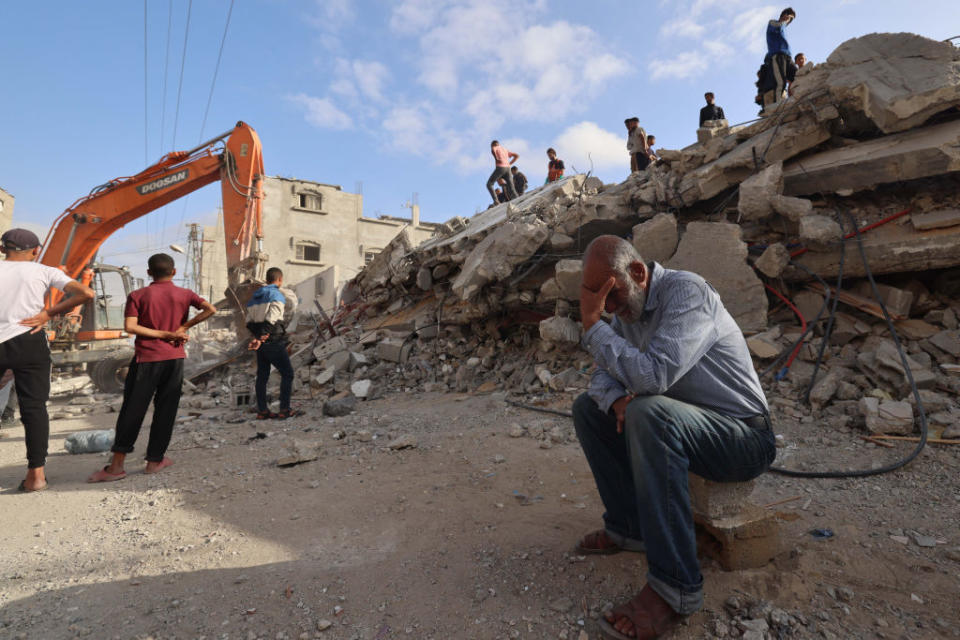20,000 Palestinian Children Are Missing in Gaza: Report

Children among the rubble and leaked sewage at Bureij camp in Deir al Balah, Gaza on June 20, 2024. Credit - Hassan Jedi—Anadolu/Getty Images
As the death toll in Gaza continues to grow amid Israel’s punishing bombardment of the Strip, so too does another statistic: the missing children. To date, at least 21,000 children are missing amid the chaos of the war, according to a new report by Save the Children—a figure the charity says includes 17,000 children who are unaccompanied or separated from their families as a result of the war and the 4,000 children who are thought to be missing under the rubble, as well as the untold number of children who have either been detained by Israeli forces or have been recently discovered in mass graves.
As with all of the statistics coming out of Gaza—including the more than 37,000-person death toll, a figure that is tracked by the Hamas-led Gaza Health Ministry and which is considered reliable by the U.S. government and the U.N.—the report notes that it is “nearly impossible” to collect and verify information under the current conditions in Gaza given the lack of access granted to aid agencies and forensic experts. But experts warn that the reality is probably far worse.
“Anyone who’s been to Gaza recently knows that these estimates are on the low end,” says Tanya Haj-Hassan, a pediatric intensive care physician who volunteered in Gaza’s Al-Aqsa hospital in March with U.K.-based charity Medical Aid for Palestinians. During her time in Gaza, Haj-Hassan says it was common after an airstrike or another mass-casualty event for family members to come to the hospital looking for their loved ones who were unaccounted for. “It’s assumed that those kids died buried under the rubble, and I don’t think those deaths are fully accounted for in these numbers.”
She recounts one time when a father, covered in soot and barefoot, came to the hospital calling out his daughter’s name, only to collapse when he realized she wasn’t there. In another, a mother arrives in a wheelchair, just one week postpartum, telling the hospital staff that her seven-day old is trapped under the rubble.

For the roughly 1 million children living in the besieged enclave, the last eight months have been defined by near-constant displacement, death, and destruction. Many are unable to get the nutrients they need as a result of man-made food shortages, creating what the U.N. and others describe as “catastrophic levels” of hunger.
Whether it’s the safety of shelter or the protection of family, or even basic necessities such as food and water and medicine, “every single means of child protection … has been targeted or destroyed,” says Haj-Hassan. “They’ve lost every other mechanism of protection that helps them grow into well developed, successful adults.”
This is perhaps most acute for children who have lost parents during the conflict, of which the Gaza Health Ministry says there are more than 15,000. “We did have multiple children in and around the hospital who were orphans,” Haj-Hassan says. “Normally with a functioning government, which existed prior to October, when a child is orphaned there are state mechanisms in place that ensure that child’s protection. Those don’t exist anymore.”
Conditions are no better for Gaza’s parents. “Families are tortured by the uncertainty of the whereabouts of their loved ones,” says Jeremy Stoner, the Middle East regional director at Save the Children. While this is a reality for parents whose children are believed to be trapped under the rubble of destroyed homes, schools, and hospitals, the children’s rights charity says it also applies to those whose children have been detained by the Israeli military. “No child should be alone, unprotected in a war zone,” Stoner says. “No child should be detained or held hostage.”

Perhaps the most notable instance of a child going missing in Gaza was the case of six-year-old Hind Rajab, who in January was trapped in a car in Gaza City alongside her relatives, all but one apart from her had been killed, when she placed an emergency call to the Palestinian Red Crescent Society pleading for help. Her body, as well as those of the emergency medics dispatched to save her, were discovered a month later. A recent investigation commissioned by Al Jazeera in collaboration with the nonprofit investigative groups Forensic Architecture and Earshot concluded that Israeli military fire was most likely responsible for the attack, which left 335 bullet holes in the Rajab family’s car. It further concluded that, at such close range, “it is not plausible that the shooter could not have seen that the car was occupied by civilians, including children.” (The Israeli military, which has previously denied that its forces were in the area at the time of the attack, could not be reached for immediate comment.)
“As many have pointed out, Gaza has become a graveyard for children, with thousands of others missing, their fates unknown,” Stoner says, adding: “We desperately need a ceasefire to find and support the missing children who have survived, and to prevent more families from being destroyed.”
Write to Yasmeen Serhan at yasmeen.serhan@time.com.


